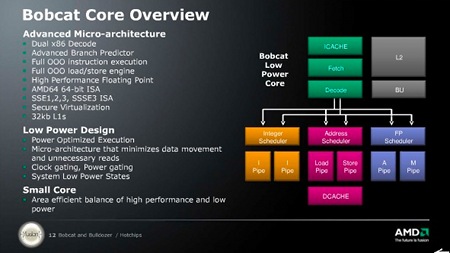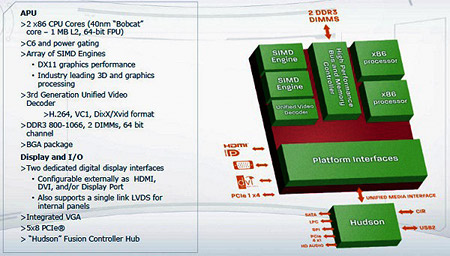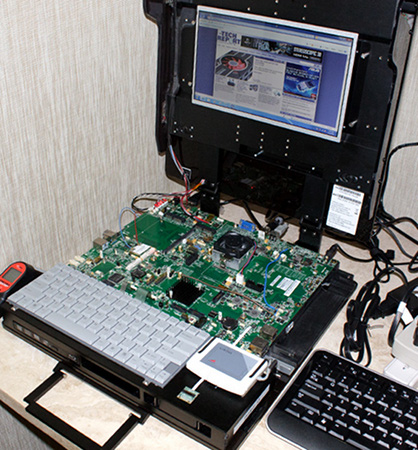AMD’s top Bobcat has the Atom licked, reviewers say
Nov 17, 2010 — by LinuxDevices Staff — from the LinuxDevices Archive — 1 viewsAMD's “Bobcat” core processor has had an unofficial coming-out party, thanks to benchmarks released by five different tech blogs. The 1.6GHz E-350 version whips a dual-core Atom CPU with Nvidia Ion 2 graphics, offering lower power consumption and even rivaling some of Intel's CULV (consumer ultra low voltage) processors, initial reviews suggest.
AMD introduced its Bobcat core during August's Hot Chips conference at Stanford University, though it had been long rumored before then. Unlike Intel's Atom — with which it will compete in netbooks and other devices — Bobcat features an out-of-order execution engine, which breaks data apart and allows for instructions to run in parallel, as well offering improved performance, the chipmaker says.

AMD's Bobcat
(Click to enlarge)
According to AMD, Bobcat (above) further features clock and power gating, allowing it to save battery life in portable devices. And, notably, it is the first x86 processor core to work with the chipmaker's APU (accelerated processing unit) design, in which the CPU and graphics are combined on one piece of silicon.
AMD has said the first Bobcat implementation, code-named "Ontario," is scheduled for a 2011 release, but still does not offer specifics on its website. Complete details of Ontario and another version called "Zacate" surfaced yesterday anyhow, courtesy of five different tech blogs: AnandTech, HotHardware, LegitReviews, PC Perspective, and The Tech Report.
Reviewers for all five blogs report having been invited to AMD's Austin campus earlier this month, when they were allowed to benchmark both Ontario and Zacate (the results having been embargoed until today). The websites also provide a common set of specs and slides from an AMD presentation, resulting in a wealth of information.

AMD's Brazos platform
(Click to enlarge)
According to the reports, AMD's overall "Brazos" platform (above) consists of an Ontario or Zacate CPU, teamed with the "Hudson" controller hub, a southbridge based on the previously released SB800. Clock speeds range from 1.0GHz to 1.6GHz, as shown in the table below.
| Model | CPU Cores |
CPU Clock Speed | GPU | Number of GPU Cores | GPU clock Speed | TDP |
| AMD E-350 | 2 | 1.6GHz | Radeon HD 6310 | 80 | 500MHz | 18W |
| AMD E-240 | 1 | 1.5GHz | Radeon HD 6310 | 80 | 500MHz | 18W |
| AMD C-50 | 2 | 1.0GHz | Radeon HD 6250 | 80 | 280MHz | 9W |
| AMD C-30 | 1 | 1.2GHz | Radeon HD 6250 | 80 | 280MHz | 9W |
AMD's Bobcat lineup
As the reviewers noted, the "Zacate" processors will have 18-Watt TDPs, and are offered as the dual-core, 1.6GHz E-350 or the single-core, 1.5GHz E-240. The "Ontario" processors have nine-Watt TDPs, and are the dual-core, 1.0GHz C-50 and the single-core, 1.2GHz C-30.
Naturally, AMD wanted the testers to experience the fastest offering: All report having been provided with a system whose reference motherboard was built around the E-350. Pictured below in an image taken by The Tech Report, the device is said to have been equipped with 4GB of RAM, a 128GB SSD (solid state disk), and a 64-bit edition of Windows 7 Professional, but reviewers were given time to install their own benchmarking software.

AMD's Brazos testbed
Source: The Techreport
(Click to enlarge)
For detailed test results, you should refer to the full reports, linked to at the end of this story. Here, we cut to the chase, summarizing each reviewer's perspective on performance, in alphabetical order, and then doing the same for their remarks about power consumption.
Performance
AnandTech's Anand Lal Shimpi reports that he purposely avoided large test suites such as PCMark Vantage or SYSMark in order to save time. Noting that the system felt "snappy," he instead employed various Photoshop and video encoding performance tests.
Shimpi writes, "In most of our benchmarks the performance advantage over Atom isn't huge, yet using Brazos is much better than using an Atom-based machine. It all boils down to one thing: single-threaded performance. Atom can make up for its deficiencies by executing a lot of threads in parallel, but when you're bound by the performance of a single thread the E-350 shines."
While it beats the Atom, the E-350 can't compete with dual-core Pentium CPUs or Core i3s, Shimpi adds. But, he said, it makes up for this by providing up to twice the GPU performance in games.
Hot Hardware's Dave Altavilla did bring such tools as PCMark Vantage and 3D Mark Vantage to the party, along with several smaller benchmarks. Noting, as did the other reviewers, that the E-350 readily provided 1080p video playback, he commented that AMD's video drivers obviously have yet to be optimized.
As an example of the above, Alatavilla found that Blu-ray playback was achieved with 33 percent CPU utilization, whereas theoretically easier H.264 decoding took around 60 percent. In any case, he added, overall E-350's performance edges out Intel's dual-core Atom D525, even when the latter's combined with Nvidia's Ion 2 GPU.
AMD's E-350 running three demanding applications at once
Source: LegitReviews
(click to play)
LegitReviews author Nathan Kirsch, who contributed the above video, reports employing PCMark Vantage as well, but notes that the results were skewed for him by the fact that the systems he'd previously tested with the tool had a variety of different disk drives — some SSD, and some not. Nonetheless, he adds, the Brazos system was more than twice as fast as Atom N270-based competitors, almost as fast as a 2.54GHz Core 2 Duo-based system, and better at gaming than any devices with integrated graphics.
PC Perspective writer Ryan Shrout reports using tools including SiSoft Sandra 2011, Cinebench 10, PCMark Vantage, and the LAME MP3 encoder to test E-350 performance. Intel's Atom D510, with or without an accompanying Nvidia Ion 2 GPU, was simply "left in the dust," he writes, and the Brazos system also managed to compete with the combo of the Ion 2 and an Intel Celeron SU2300, "the highest performing of the 'ultra low power' options currently on the market."
Finally, The Tech Report's Cyril Kowaliski employed mostly application-level bencharks, including those based on Adobe Flash, Firefox 3.6.9, TrueCrypt, Call of Duty 4: Modern Warfare, and others. To make a long story short, he concluded that the E-350 outperformed any Atom-based systems and can "play in the same league as Intel's entry-level CULV and CULV 2010 processors," pulling further ahead when graphics are taken into account.
Power consumption
AnandTech's Shimpi kicks things off here by saying that he measured about 30 Watts of total system power consumption while playing games, and an idle power consumption of around 15 Watts. However, he adds, this included the power draw of a 1366 x 768 pixel LCD panel. AMD is said to have explained that final Brazos systems will be far more power-optimized, idling at under six Watts.
Hot Hardware's Dave Altavilla came up with a power consumption high of 31 Watts and a low of 11 Watts for the Brazos system. This makes it less power-hungry than an Atom D525 system featuring an Ion 2 GPU, he writes.
LegitReviews' Kirsch again measured 11-Watt ideal power consumption and a maximum of around 30 Watts. "When playing games or watching a 1080u Blu-ray video we were hitting between 26-30 Watts and that is pretty good seeing how we were told that power numbers would only get better," he adds.
PC Perspective's Shrout gained much the same numbers. Idling at just under 10 Watts, the AMD E-350 idled at less than half of the SU2300 and Ion combination, and 76 percent less power than the Atom D510 — "very impressive results," he adds.
The Tech Report's Cyril Kowaliski cites a maximum power draw for the Brazos system of 33.6 Watts. Like several of the other reviewers, he also notes that the E-350 ran cool: 81.32 deg. F (27.4 deg. C) at idle, and 89.6 deg. F (32.5 deg. C) after the third run of a demanding gaming benchmark, for example.
Further information
The AMD Brazos reviews mentioned in this story may be found on AnandTech, here, Hot Hardware here, LegitReviews, here, PC Perspective, here, and The Tech Report, here.
This article was originally published on LinuxDevices.com and has been donated to the open source community by QuinStreet Inc. Please visit LinuxToday.com for up-to-date news and articles about Linux and open source.